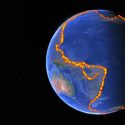Deep beneath the Earth’s surface, there’s a scorching ball of iron surrounded by an ocean of boiling hot liquid metal – the Earth’s core. It’s as toasty as the surface of the Sun, with enough heat to brew more than a trillion cups of coffee per hour. That’s over a hundred coffees for every single person on the planet.
But, what if this sizzling core suddenly cooled down? Could our planet still function with a frozen core? Or would we just become another lifeless rock orbiting the Sun?
Ever since it was formed, the inner core of the Earth has been losing heat – every billion years it becomes about 100°C (180°F) cooler. But it’s still blazing hot – around 6,000°C (10,800°F).
Of course, no one has ever been to the center of the Earth. The unbearable heat is one of the reasons you don’t want to get any closer to it. If only it cooled down a bit, maybe we could go and see what’s inside our planet, and if all our guesses about the Earth were right. But, if the Earth’s core turned cold, would we even be alive?
There are many things on Earth that make life possible. Our geomagnetic field is one of them. It protects us from all kinds of space radiation, including highly charged particles, constantly blasting from the Sun.
The magnetic field acts as a shield and deflects them around the planet. That way, no solar winds can strip away our atmosphere, which is also an essential element of life here on Earth. And guess what? This magnetic field is generated by the Earth’s core. As the planet spins, the two parts of the core – the inner solid core, and the outer liquid one – move at different speeds, generating electric currents. Those currents generate our geomagnetic field.
If the Earth’s core cooled down, it wouldn’t produce any currents. The Earth would lose its magnetic field. If that happens, be ready for all kinds of bad things. Because no magnetic field means no atmosphere, and no atmosphere… Well, in short, the Earth would start looking more like Mars.
And no breathing exercise could calm you down, since you wouldn’t even be able to breathe without a pressure suit and an oxygen mask. Since the frozen core wouldn’t heat up rocks, water, gas, and other geological material anymore, the Earth would be getting colder and colder.
On the other hand, volcanoes would no longer be spewing lava, continents would stop drifting away from each other and earthquakes would completely disappear. Nobody could survive on that Earth for too long. But it would be a good simulation of life on Mars.
Who knows, maybe we’d have enough time to pack our stuff, jump on a spaceship and get off this planet before it became absolutely dead? But if someone very curious decided to stay on Earth to finally drill a hole into the core, try to convince them not to.
The core may have lost all its heat, but the pressure there would still be 3.5 million times higher that it is on the Earth’s surface. Anyone bold enough to go there would be squeezed into the core, becoming one with the Earth, literally.
Looks like the planet’s core would be better if it remained as blisteringly hot as it is. And maybe drilling through the Earth isn’t the best idea either?
Sources
- “The Center of the Earth Is as Hot as the Sun”. Colin Schultz. Smithsonian Magazine.
- “Core”. 2015. National Geographic Society.
- “The Earth: Differentiation And Plate Tectonics”. 2020. geol105.sitehost.iu.edu.
- “Probing Question: What heats the earth’s core?”. 2008. phys.org.



























